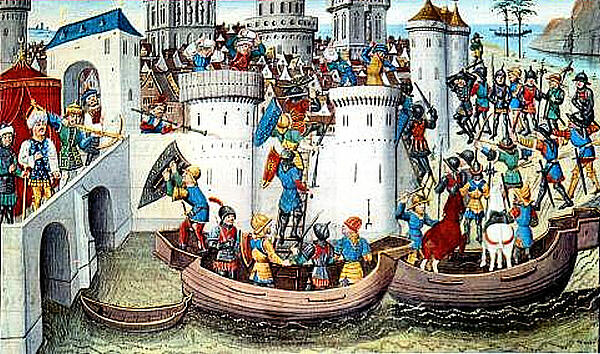The Fourth Crusade
The Fourth Crusade took place between 1201 and 1204, eight years after the end of the Third Crusade. The driving force behind the Fourth Crusade was the newly elected Pope Innocent III, who decided to launch an attack against the united Egyptians, who had Jerusalem under their control. Pope Innocent III was set on recovering the holy city of Jerusalem, following the disastrous Third Crusade which lowered the chances of being able to reclaim the Holy Land through any diplomatic means.
However, the Fourth Crusade did not recover Jerusalem, it instead saw Constantinople conquered, often referred to as 'The Sack of Constatinople', a feat which was not even on the agenda when the Crusade first started.
The Pope ordered the Crusade in 1199, but was largely ignored by European monarchs, partly due to the failure of the previous Crusade and to the fact that England and France were at war with each other. Eventually, however, recruits responded to his sanction and decided to march first to Venice, a rising power in the trade across the Mediterranean. From there they would head to Cairo, led by Boniface, the Marquis of Monferrat, a descendent of early Crusaders.

As the soldiering pilgrims could not afford to pay Venice for its provision of boats to transport 4,000 knights, 9,000 squires and 20,000 foot soldiers, plus horses, to Cairo, the Crusaders agreed to help the Venetians to capture a Byzantine port, Zara, as payment. A 15,000-strong army of Crusaders and thousands of Venetians travelled to the port, easily capturing it.
Prince Alexius IV, the son of the imprisoned ruler of Byzantine, Isaac II Angelus, then begged the Crusaders to help him drive out the usurper Alexius III and put him on the Constantinople throne. He offered the Crusaders money, ships and extra men if they agreed to help him, and it was agreed. Boniface of Montferrat hoped he may be able to recover Thessalonica as a result of these sweeteners, and the Crusaders were all keen to lay their hands on the spoils that had been promised.
The Crusaders sailed to the Byzantine capital of Constantinople, capturing the island of Corfu on the way. The Crusaders finally captured Constantinople in April 1204, after fighting off the city’s garrison of 30,000 men, weakened through lack of leadership and Civil War.
Following the successful capture of the city, thousands of valuable art works, statues and other treasures were either destroyed or stolen, something from which the Byzantine Empire never really recovered. While the named destination of the Fourth Crusade had always been Jerusalem, from the outset it seemed as though the real goal for the Crusaders was in fact the conquest of Egypt.
The Fourth Crusade angered Pope Innocent III as the Crusaders had attacked their own fellow Christians, paying no attention to the Pope's pleas to desist. The Crusaders were by now deeply unpopular and had yet to achieve their initial goal - that of regaining control of Jerusalem.
Following the capture of Constantinople, the vast majority of Crusaders returned home, many armed with the spoils of war. Over the next years a renaissance of thought occurred, harking back to the original Christian mission of the first Crusades. This ultimately led in 1217 to the Fifth Crusade.
See also: The Fifth Crusade and The Children's Crusade
MLA Citation/Reference
"The Fourth Crusade". HistoryLearning.com. 2025. Web.
